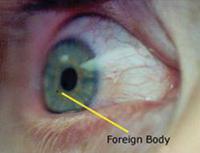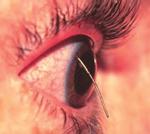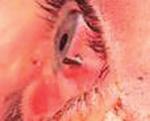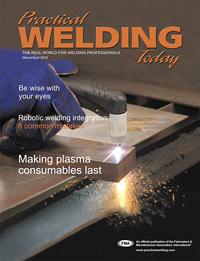Technical Product Specialist for welding, powered and supplied air respiratory products
- FMA
- The Fabricator
- FABTECH
- Canadian Metalworking
Categories
- Additive Manufacturing
- Aluminum Welding
- Arc Welding
- Assembly and Joining
- Automation and Robotics
- Bending and Forming
- Consumables
- Cutting and Weld Prep
- Electric Vehicles
- En Español
- Finishing
- Hydroforming
- Laser Cutting
- Laser Welding
- Machining
- Manufacturing Software
- Materials Handling
- Metals/Materials
- Oxyfuel Cutting
- Plasma Cutting
- Power Tools
- Punching and Other Holemaking
- Roll Forming
- Safety
- Sawing
- Shearing
- Shop Management
- Testing and Measuring
- Tube and Pipe Fabrication
- Tube and Pipe Production
- Waterjet Cutting
Industry Directory
Webcasts
Podcasts
FAB 40
Advertise
Subscribe
Account Login
Search
Heading off health hazards
Guidelines for working injury free
- By Derek Baker
- March 1, 2010
- Article
- Safety

Use caution when removing PPE or touching your face and eyes as these are the leading cause of foreign body eye injuries.
Welding, cutting, and grinding processes hold many potential health hazards. The most notable of these are injuries that result from eye and face impacts, arc radiation, inhalation of airborne contaminants, and noise. According to the organization Prevent Blindness of America, more than 700,000 Americans injure their eyes at work each year. That equates to more than 2,000 eye injuries each day, 90 percent of which could have been prevented if proper eye protection were used. Of the 700,000 eye injuries, 15,335 of them occurred while using welding equipment. According to the Bureau of Labor Statistics (BLS), 52,780 nonfatal facial injuries resulted in lost work time in 2004, and 36,680 of these were eye injuries.
Be Wise, Protect Your Eyes
Eye injuries can be classified into three categories:
- Foreign body
- Penetrating and blunt force
- Arc welding radiation exposure
Foreign Bodies. Foreign body injuries are the most prevalent, but often are not related to welding, cutting, or grinding. Foreign body injuries usually occur postoperation, when grinding chips, metal pieces, or other small particles are brushed, rubbed, or fall into the eye as other tasks or work is being performed.
Even though you may have selected and worn the correct personal protective equipment (PPE), normal human behaviors such as removing headgear or safety equipment laden with metal shavings at the end of the day; wiping sweat from your brow; or simply scratching or rubbing your eyes, eyebrow, or forehead where metal shavings are ground into the fingers or resting on the skin of a sweaty face can cause foreign body injury. Of the 36,680 eye injuries stated previously, 35.6 percent of those were caused by rubbing.
Penetrating and Blunt Force. These eye injuries often result from a direct blow to the eye and eye area. PPE eyewear designed in accordance with ANSI Z87.1-2003 Occupational and Educational Personal Eye and Face Protection Devices standard are designed to cover, at a minimum, the eye socket area of the majority of the population. These design criteria are specified to reduce the chance of objects having a direct path to the eye. Of the 36,680 eye injuries, 19 percent were caused by being struck by a flying object.
Following safe work practices and selecting and wearing proper ANSI Z87 marked PPE are the best ways to help reduce overall eye and face injuries. As noted earlier, a spectacle's basic design intent is to protect the eye area from direct impact. Goggles are designed to cover the eye area, and some provide additional protection from dust, mist, and splashes. Face shields are designed to cover the eye area, but they also help protect the face against certain flying objects. It is important to note, however, that the ANSI Z87.1 standard requires the use of spectacles as primary eye protection under all face shields and welding helmets so that in the event the face shield or welding helmet is lifted up, the eyes are still covered by the spectacles.
Consider taking additional measures to help reduce your chance of eye injuries. Wear a head covering that can be removed easily at the end of the workday to cut down on the chance of metal chips and particles becoming entrapped in the hair or top of the head. Be careful when you remove these head coverings as well as when you shower to reduce potential fallout of particles.
PPE that incorporates powered and supplied-air options may be another means to help reduce eye injuries. These types of PPE often cover a large portion of your head and face and increase your comfort level by providing constant airflow across the head and face. This added comfort increases the likelihood of the product being worn, and worn correctly, further reducing potential injuries and helping enhance productivity.
Gloves also may reduce the chance of metal particles becoming ingrained in the skin, potentially reducing the rub-in effect.
Arc Radiation Exposure. Exposure to arc welding radiation is another form of eye injury. The three types of light emitted from a welding arc are ultraviolet (UV), visible, and infrared (IR). Visible light is the portion of light that can be seen by the eye easily. UV and IR light cannot be seen but are extremely dangerous and can cause painful and immediate eye injuries commonly known as "arc eye," which is essentially a sunburn of the cornea.
Multiple overexposures to UV and IR light can cause cumulative eye injuries that, if left unprotected, can ultimately lead to blindness and other permanent eye injuries. In addition to eye injuries, constant exposure to UV light may also damage the skin and contribute to skin cancer and other skin conditions. Using sunblock with an SPF of 50 or higher may also help protect you from overexposure to UV light.
According to the ANSI Z87.1 standard, you are required to wear primary eye protection under all welding helmets. Primary eye protection constitutes Z87 or Z87+ marked safety spectacles or goggles that will effectively block most of the UV light spectrum. Wearing safety spectacles under the welding helmet can significantly reduce eye damage from UV light even while the helmet is in the up position. Some specialty safety spectacles can provide additional protection against the IR component of light.
A quality autodarkening welding helmet may help reduce eye injuries caused by arc radiation. Typically, welders who wear an autodarkening helmet leave the helmet in the down position more frequently than traditional passive welding helmets. This helps protect the eyes from stray and reflected arc radiation and also flying objects that contribute to foreign body and blunt force eye injuries. A quality autodarkening helmet can help reduce your exposure to arc radiation and other foreign body eye injuries, and may enhance productivity and comfort.
Inhaling Airborne Contaminants
Some welding, cutting, and grinding processes produce airborne contaminants that may require you to use a respiratory protection device. These contaminants can be in the form of particles or gases and vapors. Some examples of particles are metal fumes, dusts, and mists; examples of gases and vapors are ozone, fluorides, and shielding gases.
Hexavalent chromium (CrVI) is one of the potential particulate exposures regulated by OSHA. In February 2006, OSHA required employers to measure worker exposure to hexavalent chromium and establish control measures accordingly. OSHA reduced the permissible exposure limit (PEL) from a value of 52mg/m3 to a value of 5mg/m3 or a drop in exposure limits by more than an order of magnitude. OSHA has given employers until May 31, 2010, to place engineering controls in place, and if that is not feasible, to develop an effective respiratory protection program.
In most cases, an N95 particulate filter provides sufficient filtering capabilities. Depending on the results of worker air sampling and exposures, a half-facepiece respirator, such as a disposable filtering facepiece respirator with an assigned protection factor (APF) of 10, or a powered or supplied-air respiratory system providing an APF of 1,000, may be required.
In addition to hexavalent chromium, other respiratory hazards may be present depending on the application or process. If air quality is in question, you should consult an industrial hygienist to perform a workplace assessment of your facility.
Noise Hazards
Welding, cutting, and grinding processes are often noisy and may require hearing conservation programs to mitigate noise hazards in these types of areas. There are five required elements of OSHA's hearing conservation standard, 29 CFR 1910.95:
- Noise monitoring
- Annual hearing testing
- Hearing protection methods
- Annual training
- Recordkeeping
Environments that have a time weighted average (TWA) greater than 85 dBA require a hearing conservation program. As part of the program if the TWA is greater than 90 dBA, workers must wear hearing protection to reduce the TWA to less than 90 dBA. Additionally, employers must provide a suitable variety of hearing protection devices—two or more—to allow options for employees regarding fit and comfort.
The best hearing protectors are those that are worn correctly, have good fit, are worn consistently, and are comfortable. Many types of hearing protection devices (HPDs) are offered on the market today. HPDs include disposable foam earplugs, reusable molded earplugs, banded devices, and earmuffs with and without built-in communications.
When selecting an HPD, consider the performance or noise reduction and attenuation of the device. Also consider the effect the HPD has on communications and whether it will cause any adverse safety concerns while being worn. Next consider the comfort of the HPD throughout the wearing period. A device may be comfortable at first but become uncomfortable over a period of time. Next consider the ease of use: Is it easy to remove and reinsert into the ear, and is it compatible with other PPE used in the environment?
Last, consider the physical properties and ask how durable the device needs to be and the initial and long-term investment of the device. These basic questions will help you in selecting a suitable HPD.
About the Author
Derek Baker
3M Center
St. Paul, MN 55144-1000
651-737-4265
About the Publication
Related Companies
subscribe now

The Welder, formerly known as Practical Welding Today, is a showcase of the real people who make the products we use and work with every day. This magazine has served the welding community in North America well for more than 20 years.
start your free subscription- Stay connected from anywhere

Easily access valuable industry resources now with full access to the digital edition of The Fabricator.

Easily access valuable industry resources now with full access to the digital edition of The Welder.

Easily access valuable industry resources now with full access to the digital edition of The Tube and Pipe Journal.
- Podcasting
- Podcast:
- The Fabricator Podcast
- Published:
- 04/16/2024
- Running Time:
- 63:29
In this episode of The Fabricator Podcast, Caleb Chamberlain, co-founder and CEO of OSH Cut, discusses his company’s...
- Trending Articles
Sheffield Forgemasters makes global leap in welding technology

Welding student from Utah to represent the U.S. at WorldSkills 2024

Lincoln Electric announces executive appointments

Lincoln Electric acquires RedViking

Engine-driven welding machines include integrated air compressors

- Industry Events
16th Annual Safety Conference
- April 30 - May 1, 2024
- Elgin,
Pipe and Tube Conference
- May 21 - 22, 2024
- Omaha, NE
World-Class Roll Forming Workshop
- June 5 - 6, 2024
- Louisville, KY
Advanced Laser Application Workshop
- June 25 - 27, 2024
- Novi, MI





























